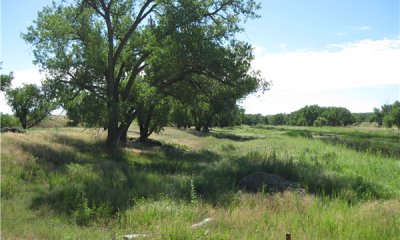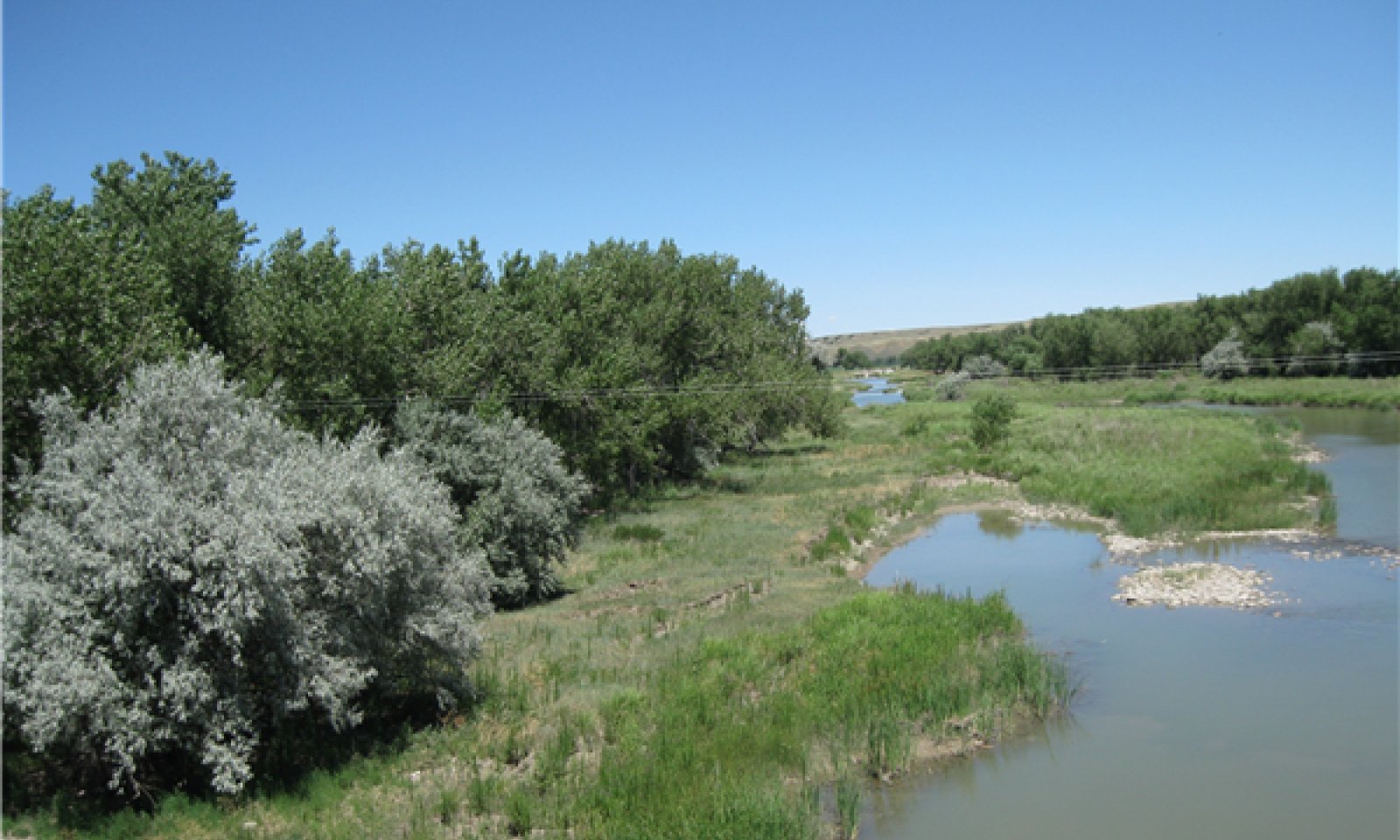
Loamy Overflow
Scenario model
Current ecosystem state
Select a state
Management practices/drivers
Select a transition or restoration pathway
- Transition T1A More details
- Transition T1B More details
- Transition T2A More details
- Transition T2B More details
- Restoration pathway R3A More details
- Transition T3A More details
- Transition T4B More details
- Transition T4A More details
- Transition T5A More details
-
No transition or restoration pathway between the selected states has been described
Target ecosystem state
Select a state
Description
This State represents what is believed to exist prior to European settlement. The Reference State may exist but is unlikely to function within the natural rage of variability due to the spread of Kentucky bluegrass and smooth brome onto this site. In the Reference State, this site is dominated by warm-and cool- season grasses, and various shrub and tree species that are scattered across the site. Grazing or the lack of grazing, flooding or lack of flooding, fire, excessive haying, and invasion of non-native cool-season grasses are the major drivers of this State. Flooding and no fire on this site can cause a transition to a Woody Overstory State (4.0).
Submodel
Description
This State has a significant amount of Kentucky bluegrass or smooth brome in the plant community but they have not become the dominate species. In this State, Kentucky bluegrass makes up less than 30 percent of the plant community composition (by weight). This State is at risk of transitioning to a bluegrass dominated Invaded State (3.0).
Submodel
Description
This state is the result of invasion and dominance of introduced species. This state is characterized by the dominance of Kentucky bluegrass and smooth brome, and an increasing thatch layer that effectively blocks introduction of other plants into the system. Plant litter accumulation tends to favor the more shade tolerant, introduced grass species. The nutrient cycle is also impaired, and the result is typically a higher level of nitrogen which also favors the introduced species. Increasing plant litter decreases the amount of sunlight reaching plant crowns thereby shifting competitive advantage to shade tolerant, introduced grass species. Studies indicate that soil biological activity is altered, and this shift apparently exploits the soil microclimate and encourages growth of the introduced grass species. Once the threshold is crossed, a change in grazing management alone cannot cause a reduction in the invasive grass dominance. Preliminary studies would tend to indicate this threshold may exist when Kentucky bluegrass exceeds 30 percent of the plant community and native grasses represent less than 40 percent of the plant community composition. Plant communities dominated by Kentucky bluegrass have significantly less cover and diversity of native grasses and forb species (Toledo, D. et al., 2014).
Submodel
Description
This State is the result of the establishment of a tree overstory and shrub mid-story canopy. This State is more common on the lower reaches of the site. The dynamics of this State are largely due to flooding and successional changes, starting with cottonwood and shrub establishment, and eventually the development of a green ash and boxelder plant community. The successional process can restart following another flooding event. Water control structures which limit flooding, livestock grazing, heavy wildlife browse, fire, and the introduction of non-native, cool-season grasses can alter the dynamics of this site resulting in old remnant stands of trees with little, if any regeneration.
Down cutting of the drainageway or stream channel will eventually leave the overflow site on a higher and drier landscape position. In this case the site will be described as the Loamy Terrace Ecological Site (R060AY022SD).
Submodel
Description
This State developed as a result of the invasion of Russian olive and/or saltcedar in combination with continuous season-long grazing, or continuous seasonal grazing, or fire. With time, the cottonwood, boxelder and ash trees that survive become mature, and little or no regeneration occurs. This is due mainly to grazing of seedlings and saplings. Wildlife browse can also contribute to the loss of native tree and shrub regeneration. Grazing that limits regeneration also results in a reduction of the desirable native herbaceous species, often resulting in a dominance of species such as bluegrass and/or smooth brome, and forbs such as western ragweed, Canada thistle, burdock, and hound’s tongue.
Submodel
Mechanism
Continuous season-long grazing and/or excessive haying and the invasion of non-native cool-season grasses will convert this plant community to the Native/Invaded State (2.0).
Mechanism
T1B Flooding, followed by long-term prescribed grazing, and no fire can transition this plant community to the Woody Overstory State (4.0). This State is more likely to occur on the mid to lower reaches of a drainage.
Mechanism
Continuous season-long grazing and/or excessive haying in addition to the spread of non-native cool-season grasses will result in a transition to the Invaded State (3.0). The spread of non-native invasive trees species is also a possibility.
Mechanism
Flooding and no fire followed, by long-term prescribed grazing, including proper stocking, change in season of use, and adequate time for recovery will likely transition this site to the Woody Overstory State (4.0). Timed grazing is very important and must be followed for many years in order for saplings to attain a height where livestock will not damage and/or kill the trees. Wildlife browse can also be a concern if the management objective are to improve the overstory canopy. The Woody Overstory State is more likely to occur on the mid to lower reaches of a drainage.
Mechanism
Long term prescribed grazing and/or prescribed burning may transition the plant community toward the Native/Invaded State (2.0). This is assuming an adequate seed/vegetative source is available. This transition my take an extended period of time and in the end not meet management objectives.
Mechanism
Invasion of non-native tree species, continuous season-long grazing, continuous seasonal grazing and time will transition the Invaded State (3.0) to the Woody Invaded State (5.0).
Mechanism
Fire, invasion of non-native, cool-season grasses, continuous season-long grazing, or continuous seasonal grazing resulting in little woody regeneration, and time will transition this state to the Native/Invaded State (2.0).
Mechanism
Invasion of non-native tree species in combination with continuous season-long grazing, continuous seasonal grazing, heavy wildlife browse, or fire can cause any of the plant communities in the Woody Overstory State (4.0) to transition to the Woody Invaded State (5.0).
Model keys
Briefcase
Add ecological sites and Major Land Resource Areas to your briefcase by clicking on the briefcase (![]() ) icon wherever it occurs. Drag and drop items to reorder. Cookies are used to store briefcase items between browsing sessions. Because of this, the number of items that can be added to your briefcase is limited, and briefcase items added on one device and browser cannot be accessed from another device or browser. Users who do not wish to place cookies on their devices should not use the briefcase tool. Briefcase cookies serve no other purpose than described here and are deleted whenever browsing history is cleared.
) icon wherever it occurs. Drag and drop items to reorder. Cookies are used to store briefcase items between browsing sessions. Because of this, the number of items that can be added to your briefcase is limited, and briefcase items added on one device and browser cannot be accessed from another device or browser. Users who do not wish to place cookies on their devices should not use the briefcase tool. Briefcase cookies serve no other purpose than described here and are deleted whenever browsing history is cleared.
Ecological sites
Major Land Resource Areas
The Ecosystem Dynamics Interpretive Tool is an information system framework developed by the USDA-ARS Jornada Experimental Range, USDA Natural Resources Conservation Service, and New Mexico State University.


